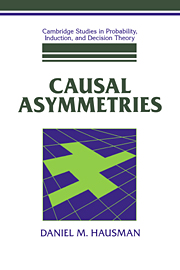Book contents
- Frontmatter
- Contents
- List of Figures
- Acknowledgments
- Introduction: Causation and its Asymmetries
- 1 Metaphysical Pictures and Wishes
- 1* Transfer Theories
- 2 Is Causation a Relation Among Events?
- 3 Causation, Regularities, and Time: Hume's Theory
- 4 Causation and Independence
- 4* Causation, Independence, and Causal Connection
- 5 Agency Theory
- 5* Causal Generalizations and Agency
- 6 The Counterfactual Theory
- 6* Independence and Counterfactual Dependence
- 7 Counterfactuals, Agency, and Independence
- 7* Agency, Counterfactuals, and Independence
- 8 Causation, Explanation, and Laws
- 8* Causation, Explanation, and Independent Alterability
- 9 Probabilistic Causation
- 10 Causation and Conditional Probabilities
- 10* Causal Graphs and Conditional Probabilistic Dependencies
- 11 Intervention, Robustness, and Probabilistic Dependence
- 11* Interventions and Conditional Probabilities
- 12 Operationalizing and Revising the Independence Theory
- 12* Probability Distributions and Causation
- 13 Complications and Conclusions
- Appendix A Alphabetical List of Propositions
- Appendix B List of Theorems
- References
- Index
9 - Probabilistic Causation
Published online by Cambridge University Press: 20 April 2010
- Frontmatter
- Contents
- List of Figures
- Acknowledgments
- Introduction: Causation and its Asymmetries
- 1 Metaphysical Pictures and Wishes
- 1* Transfer Theories
- 2 Is Causation a Relation Among Events?
- 3 Causation, Regularities, and Time: Hume's Theory
- 4 Causation and Independence
- 4* Causation, Independence, and Causal Connection
- 5 Agency Theory
- 5* Causal Generalizations and Agency
- 6 The Counterfactual Theory
- 6* Independence and Counterfactual Dependence
- 7 Counterfactuals, Agency, and Independence
- 7* Agency, Counterfactuals, and Independence
- 8 Causation, Explanation, and Laws
- 8* Causation, Explanation, and Independent Alterability
- 9 Probabilistic Causation
- 10 Causation and Conditional Probabilities
- 10* Causal Graphs and Conditional Probabilistic Dependencies
- 11 Intervention, Robustness, and Probabilistic Dependence
- 11* Interventions and Conditional Probabilities
- 12 Operationalizing and Revising the Independence Theory
- 12* Probability Distributions and Causation
- 13 Complications and Conclusions
- Appendix A Alphabetical List of Propositions
- Appendix B List of Theorems
- References
- Index
Summary
There are two main motivations for developing a theory of probabilistic causation. The first is esoteric. According to contemporary physics, many occurrences are not determined. A complete specification of the state of some ensemble only determines a set of probabilities. Despite the temptation to maintain that what happens by chance is not caused, causal questions remain. When one sends a photon through a slit and illuminates a particular square on a grid behind the slit, one wants to say that sending the photon through the slit caused the square to be illuminated, even when the transmission of the photon created only a small probability that the particular square would be illuminated. There are also probabilistic phenomena involving large numbers of individuals, like those in statistical mechanics, that apparently call for probabilistic explanation, even though the relations among the individuals may be deterministic.
The second motivation is more prosaic. As is argued with special vividness by Elizabeth Anscombe (1971), causal attributions in everyday life often appear nondeterministic. People say that punishments deter theft even though they do not believe that the deterrence is perfect. People say that dropping a glass caused it to break, even though they are aware of similar circumstances in which similar glasses were dropped and did not break (see also Rosen 1982).
These prosaic cases do not force one to conclude that the causal relation is not deterministic. Many causal factors influence thefts in addition to the threat of punishment. One can conjecture that the threat of punishment completely deters theft given certain arrays of these other factors, and that it does not deter theft given other arrays.
- Type
- Chapter
- Information
- Causal Asymmetries , pp. 185 - 206Publisher: Cambridge University PressPrint publication year: 1998

